Remediation of Cd-Contaminated Soil by Modified Nanoscale Zero-Valent Iron: Role of Plant Root Exudates and Inner Mechanisms
Abstract
:1. Introduction
2. Materials and Methods
2.1. Soil Characterization and Preparation
2.2. Nanoparticles Synthesis and Characterization
2.3. Experimental Design of Simulated Pore Water and Rhizosphere Environment
2.4. Fractions of Cd in the Soil Samples
2.5. Methods for the Detection of Soil Physico–Chemical Properties
2.6. High-Throughput Sequencing
2.7. Statistical Analysis
3. Results and Discussion
3.1. Materials Characterization
3.2. Effect of CA Concentration on Removal of Cd(Ⅱ) from Aqueous Phase
3.3. Effect of CA on the Removal of Cd2+ from Water by Modified nZVI under Different pH
3.4. The Changes of Reaction Products in the Water System
3.5. Distribution of Cd Speciation in Soil Samples
3.6. Changes in Soil Properties
3.7. Shift of Bacterial Community Composition and Structure under the Experimental Conditions
3.8. The Interaction Mechanism between CA and nZVI under Cd Stress and the Response Mechanism of Microorganisms
4. Conclusions
Supplementary Materials
Author Contributions
Funding
Institutional Review Board Statement
Informed Consent Statement
Data Availability Statement
Acknowledgments
Conflicts of Interest
References
- Gong, X.M.; Huang, D.L.; Liu, Y.G.; Zeng, G.M.; Wang, R.Z.; Wan, J.; Zhang, C.; Cheng, M.; Qin, X.; Xue, W.J. Stabilized Nanoscale Zerovalent Iron Mediated Cadmium Accumulation and Oxidative Damage of Boehmeria nivea (L.) Gaudich Cultivated in Cadmium Contaminated Sediments. Environ. Sci. Technol. 2017, 51, 11308–11316. [Google Scholar] [CrossRef]
- Tan, X.P.; Wang, Z.Q.; Lu, G.N.; He, W.X.; Wei, G.H.; Huang, F.; Xu, X.L.; Shen, W.J. Kinetics of soil dehydrogenase in response to exogenous Cd toxicity. J. Hazard. Mater. 2017, 329, 299–309. [Google Scholar] [CrossRef]
- Huang, D.L.; Xue, W.J.; Zeng, G.M.; Wan, J.; Chen, G.M.; Huang, C.; Zhang, C.; Cheng, M.; Xu, P.A. Immobilization of Cd in river sediments by sodium alginate modified nanoscale zero-valent iron: Impact on enzyme activities and microbial community diversity. Water Res. 2016, 106, 15–25. [Google Scholar] [CrossRef]
- Najeeb, U.; Jilani, G.; Ali, S.; Sarwar, M.; Xu, L.; Zhou, W. Insights into cadmium induced physiological and ultra-structural disorders in Juncus effusus L. and its remediation through exogenous citric acid. J. Hazard. Mater. 2011, 186, 565–574. [Google Scholar] [CrossRef] [PubMed]
- Wang, Y.-J.; Fan, T.-T.; Cui, P.-X.; Sun, Q.; Zhou, D.-M.; Li, C.-B.; Wang, G.-Q.; Lin, Y.-S.; Zhang, S.-T.; Yang, X.-P.; et al. Binding and Adsorption Energy of Cd in Soils and Its Environmental Implication for Cd Bioavailability. Soil Sci. Soc. Am. J. 2020, 84, 472–482. [Google Scholar] [CrossRef]
- Xue, W.; Peng, Z.; Huang, D.; Zeng, G.; Wan, J.; Xu, R.; Cheng, M.; Zhang, C.; Jiang, D.; Hu, Z. Nanoremediation of cadmium contaminated river sediments: Microbial response and organic carbon changes. J. Hazard. Mater. 2018, 359, 290–299. [Google Scholar] [CrossRef]
- Vítková, M.; Puschenreiter, M.; Komárek, M. Effect of nano zero-valent iron application on As, Cd, Pb, and Zn availability in the rhizosphere of metal(loid) contaminated soils. Chemosphere 2018, 200, 217–226. [Google Scholar] [CrossRef] [PubMed]
- Ken, D.S.; Sinha, A. Recent developments in surface modification of nano zero-valent iron (nZVI): Remediation, toxicity and environmental impacts. Environ. Nanotechnol. Monit. Manag. 2020, 14, 100344–100364. [Google Scholar] [CrossRef]
- Hu, Y.; Wang, J.; Sun, H.W.; Wang, S.H.; Liao, X.M.; Wang, J.; An, T.C. Roles of extracellular polymeric substances in the bactericidal effect of nanoscale zero-valent iron: Trade-offs between physical disruption and oxidative damage. Environ. Sci. Nano 2019, 6, 2061–2073. [Google Scholar] [CrossRef]
- Kocur, C.M.D.; Lomheim, L.; Boparai, H.K.; Chowdhury, A.I.A.; Weber, K.P.; Austrins, L.M.; Edwards, E.A.; Sleep, B.E.; O’Carroll, D.M. Contributions of Abiotic and Biotic Dechlorination Following Carboxymethyl Cellulose Stabilized Nanoscale Zero Valent Iron Injection. Environ. Sci. Technol. 2015, 49, 8648–8656. [Google Scholar] [CrossRef]
- Kim, J.Y.; Lee, C.; Love, D.C.; Sedlak, D.L.; Yoon, J.; Nelson, K.L. Inactivation of MS2 Coliphage by Ferrous Ion and Zero-Valent Iron Nanoparticles. Environ. Sci. Technol. 2011, 45, 6978–6984. [Google Scholar] [CrossRef]
- Ma, X.; Gurung, A.; Deng, Y. Phytotoxicity and uptake of nanoscale zero-valent iron (nZVI) by two plant species. Sci. Total Environ. 2013, 443, 844–849. [Google Scholar] [CrossRef]
- Wu, S.L.; Cajthaml, T.; Semerad, J.; Filipova, A.; Klementova, M.; Skala, R.; Vitkova, M.; Michalkova, Z.; Teodoro, M.; Wu, Z.X.; et al. Nano zero-valent iron aging interacts with the soil microbial community: A microcosm study. Environ. Sci. Nano 2019, 6, 1189–1206. [Google Scholar] [CrossRef]
- Xu, W.; Li, Z.; Shi, S.; Qi, J.; Cai, S.; Yu, Y.; O’Carroll, D.M.; He, F. Carboxymethyl cellulose stabilized and sulfidated nanoscale zero-valent iron: Characterization and trichloroethene dechlorination. Appl. Catal. B Environ. 2020, 262, 118303–118315. [Google Scholar] [CrossRef]
- He, F.; Zhao, D. Manipulating the Size and Dispersibility of Zerovalent Iron Nanoparticles by Use of Carboxymethyl Cellulose Stabilizers. Environ. Sci. Technol. 2007, 41, 6216–6221. [Google Scholar] [CrossRef] [PubMed]
- Zhao, X.; Liu, W.; Cai, Z.; Han, B.; Qian, T.; Zhao, D. An overview of preparation and applications of stabilized zero-valent iron nanoparticles for soil and groundwater remediation. Water Res. 2016, 100, 245–266. [Google Scholar] [CrossRef] [PubMed] [Green Version]
- Dong, H.; Zhao, F.; Zeng, G.; Tang, L.; Fan, C.; Zhang, L.; Zeng, Y.; He, Q.; Xie, Y.; Wu, Y. Aging study on carboxymethyl cellulose-coated zero-valent iron nanoparticles in water: Chemical transformation and structural evolution. J. Hazard. Mater. 2016, 312, 234–242. [Google Scholar] [CrossRef] [PubMed]
- Raychoudhury, T.; Tufenkji, N.; Ghoshal, S.J.W.R. Aggregation and deposition kinetics of carboxymethyl cellulose-modified zero-valent iron nanoparticles in porous media. Water Res. 2012, 46, 1735–1744. [Google Scholar] [CrossRef]
- Dong, H.; Xie, Y.; Zeng, G.; Tang, L.; Liang, J.; He, Q.; Zhao, F.; Zeng, Y.; Wu, Y. The dual effects of carboxymethyl cellulose on the colloidal stability and toxicity of nanoscale zero-valent iron. Chemosphere 2016, 144, 1682–1689. [Google Scholar] [CrossRef]
- Zhou, L.; Thanh, T.L.; Gong, J.; Kim, J.-H.; Kim, E.-J.; Chang, Y.-S. Carboxymethyl cellulose coating decreases toxicity and oxidizing capacity of nanoscale zerovalent iron. Chemosphere 2014, 104, 155–161. [Google Scholar] [CrossRef]
- Xue, W.; Huang, D.; Zeng, G.; Wan, J.; Zhang, C.; Xu, R.; Cheng, M.; Deng, R. Nanoscale zero-valent iron coated with rhamnolipid as an effective stabilizer for immobilization of Cd and Pb in river sediments. J. Hazard. Mater. 2018, 341, 381–389. [Google Scholar] [CrossRef]
- Luo, Q.; Sun, L.N.; Hu, X.M.; Zhou, R.R. The Variation of Root Exudates from the Hyperaccumulator Sedum alfredii under Cadmium Stress: Metabonomics Analysis. PLoS ONE 2014, 9, e115581. [Google Scholar] [CrossRef]
- Ubeynarayana, N.; Jeyakumar, P.; Bishop, P.; Pereira, R.C.; Anderson, C.W.N. Effect of soil cadmium on root organic acid secretion by forage crops. Environ. Pollut. 2021, 268. [Google Scholar] [CrossRef] [PubMed]
- Ehsan, S.; Ali, S.; Noureen, S.; Mahmood, K.; Farid, M.; Ishaque, W.; Shakoor, M.B.; Rizwan, M. Citric acid assisted phytoremediation of cadmium by Brassica napus L. Ecotoxicol. Environ. Saf. 2014, 106, 164–172. [Google Scholar] [CrossRef] [PubMed]
- Hassen, A.; Saidi, N.; Cherif, M.; Boudabous, A. Effects of heavy metals on Pseudomonas aeruginosa and Bacillus thuringiensis. Bioresour. Technol. 1998, 65, 73–82. [Google Scholar] [CrossRef]
- Jia, H.; Hou, D.; Dai, M.; Lu, H.; Yan, C. Effects of root exudates on the mobility of pyrene in mangrove sediment-water system. CATENA 2018, 162, 396–401. [Google Scholar] [CrossRef]
- Gómez, J.; García, S.; Esteban, E.; Zornoza, P.; Carpena, R.O. The role of root organic acids in the tolerance of Festuca rubra to zinc, lead and cadmium. Toxicol. Environ. Chem. 2020, 102, 399–414. [Google Scholar] [CrossRef]
- Carlos, R.S.; Luciana, P.S.V.; Cristine, R.; Ashok, P. New Perspectives for Citric Acid Production and Application. Food Technol. Biotechnol. 2006, 44, 141–149. [Google Scholar]
- Salihu, R.; Abd Razak, S.I.; Ahmad Zawawi, N.; Rafiq Abdul Kadir, M.; Izzah Ismail, N.; Jusoh, N.; Riduan Mohamad, M.; Hasraf Mat Nayan, N. Citric acid: A green cross-linker of biomaterials for biomedical applications. Eur. Polym. J. 2021, 146, 110271. [Google Scholar] [CrossRef]
- Wang, S.; Dong, Q.; Wang, Z. Differential effects of citric acid on cadmium uptake and accumulation between tall fescue and Kentucky bluegrass. Ecotoxicol. Environ. Saf. 2017, 145, 200–206. [Google Scholar] [CrossRef] [PubMed]
- Zhang, Y.; Li, F.; Xu, W.; Ren, J.; Chen, S.; Shen, K.; Long, Z. Enhanced Phytoextraction for Co-contaminated Soil with Cd and Pb by Ryegrass (Lolium perenne L.). Bull. Environ. Contam. Toxicol. 2019, 103, 147–154. [Google Scholar] [CrossRef] [PubMed]
- He, S.; Wu, Q.; He, Z. Growth-Promoting Hormone DA-6 Assists Phytoextraction and Detoxification of Cd by Ryegrass. Int. J. Phytoremediation 2015, 17, 597–603. [Google Scholar] [CrossRef]
- Wang, J.; Fang, Z.Q.; Cheng, W.; Yan, X.M.; Tsang, P.E.; Zhao, D.Y. Higher concentrations of nanoscale zero-valent iron (nZVI) in soil induced rice chlorosis due to inhibited active iron transportation. Environ. Pollut. 2016, 210, 338–345. [Google Scholar] [CrossRef]
- Nemati, K.; Bakar, N.K.A.; Abas, M.R.; Sobhanzadeh, E. Speciation of heavy metals by modified BCR sequential extraction procedure in different depths of sediments from Sungai Buloh, Selangor, Malaysia. J. Hazard. Mater. 2011, 192, 402–410. [Google Scholar] [CrossRef]
- Deng, R.; Huang, D.; Xue, W.; Lei, L.; Chen, S.; Zhou, C.; Liu, X.; Wen, X.; Li, B. Eco-friendly remediation for lead-contaminated riverine sediment by sodium lignin sulfonate stabilized nano-chlorapatite. Chem. Eng. J. 2020, 397, 125396–125406. [Google Scholar] [CrossRef]
- Ovreas, L.; Forney, L.; Daae, F.L.; Torsvik, V. Distribution of bacterioplankton in meromictic Lake Saelenvannet, as determined by denaturing gradient gel electrophoresis of PCR-amplified gene fragments coding for 16S rRNA. Appl. Environ. Microbiol. 1997, 63, 3367–3373. [Google Scholar] [CrossRef] [PubMed] [Green Version]
- Zheng, Y.; Yan, Y.; Yu, L.; Li, H.; Jiao, B.; Shiau, Y.; Li, D. Synergism of citric acid and zero-valent iron on Cr(VI) removal from real contaminated soil by electrokinetic remediation. Environ. Sci. Pollut. Res. 2020, 27, 5572–5583. [Google Scholar] [CrossRef] [PubMed]
- Arsenov, D.; Župunski, M.; Borišev, M.; Nikolić, N.; Pilipovic, A.; Orlovic, S.; Kebert, M.; Pajevic, S. Citric acid as soil amendment in cadmium removal by Salix viminalis L., alterations on biometric attributes and photosynthesis. Int. J. Phytoremediation 2020, 22, 29–39. [Google Scholar] [CrossRef] [PubMed]
- Stumm, W.; Morgan, J.J. Aquatic chemistry: Chemical equilibria and rates in naturalwaters. Environ. Sci. Technol. 1995, 179, A277. [Google Scholar]
- Zhang, Y.L.; Li, Y.T.; Dai, C.M.; Zhou, X.F.; Zhang, W.X. Sequestration of Cd(II) with nanoscale zero-valent iron (nZVI): Characterization and test in a two-stage system. Chem. Eng. J. 2014, 244, 218–226. [Google Scholar] [CrossRef]
- Manceau, A.; Nagy, K.L.; Spadini, L.; Ragnarsdottir, K.V. Influence of anionic layer structure of Fe-oxyhydroxides on the structure of Cd surface complexes. J. Colloid Interface Sci. 2000, 228, 306–316. [Google Scholar] [CrossRef]
- Randall, S.R.; Sherman, D.M.; Ragnarsdottir, K.V.; Collins, C.R. The mechanism of cadmium surface complexation on iron oxyhydroxide minerals. Geochim. et Cosmochim. Acta 1999, 63, 2971–2987. [Google Scholar] [CrossRef]
- Gao, X.; Avellan, A.; Laughton, S.; Vaidya, R.; Rodrigues, S.M.; Casman, E.A.; Lowry, G.V. CuO Nanoparticle Dissolution and Toxicity to Wheat (Triticum aestivum) in Rhizosphere Soil. Environ. Sci. Technol. 2018, 52, 2888–2897. [Google Scholar] [CrossRef]
- Faraz, A.; Faizan, M.; Sami, F.; Siddiqui, H.; Hayat, S. Supplementation of Salicylic Acid and Citric Acid for Alleviation of Cadmium Toxicity to Brassica juncea. J. Plant Growth Regul. 2020, 39, 641–655. [Google Scholar] [CrossRef]
- Liu, H.; Liu, Y.-G.; Zeng, G.-M.; Xie, J.-L.; Zheng, B.-H.; Tan, X.-F.; Wang, D.-F.; Sun, Z.-C.; Nie, J.; Jiang, Z.-J.; et al. Mitigation mechanism of Cd-contaminated soils by different levels of exogenous low-molecular-weight organic acids and Phytolacca americana. RSC Adv. 2015, 5, 45502–45509. [Google Scholar] [CrossRef]
- Wang, L.; Lv, D.Q.; Tan, Z.B.; Wang, H.; Hou, X.L.; Liu, X.M. Review and Analysis of Soil Physical and Chemical Characteristics on Woodland Slop in Yuelu Mountain. J. Nat. Sci. Hunan Norm. Univ. 2011, 34, 84–88. [Google Scholar] [CrossRef]
- Boparai, H.K.; Joseph, M.; O’Carroll, D.M. Cadmium (Cd2+) removal by nano zerovalent iron: Surface analysis, effects of solution chemistry and surface complexation modeling. Environ. Sci. Pollut. Res. 2013, 20, 6210–6221. [Google Scholar] [CrossRef] [PubMed]
- Zhang, J.; Yin, H.; Wang, H.; Xu, L.; Samuel, B.; Liu, F.; Chen, H. Reduction mechanism of hexavalent chromium by functional groups of undissolved humic acid and humin fractions of typical black soil from Northeast China. Environ. Sci. Pollut. Res. 2018, 25, 16913–16921. [Google Scholar] [CrossRef]
- Guo, H.; Nasir, M.; Lv, J.; Dai, Y.; Gao, J. Understanding the variation of microbial community in heavy metals contaminated soil using high throughput sequencing. Ecotoxicol. Environ. Saf. 2017, 144, 300–306. [Google Scholar] [CrossRef] [PubMed]
- Gomez-Sagasti, M.T.; Epelde, L.; Anza, M.; Urra, J.; Alkorta, I.; Garbisu, C. The impact of nanoscale zero-valent iron particles on soil microbial communities is soil dependent. J. Hazard. Mater. 2019, 364, 591–599. [Google Scholar] [CrossRef] [PubMed]
- Huang, L.; Wang, Q.; Zhou, Q.; Ma, L.; Wu, Y.; Liu, Q.; Wang, S.; Feng, Y. Cadmium uptake from soil and transport by leafy vegetables: A meta-analysis. Environ. Pollut. 2020, 264, 114677. [Google Scholar] [CrossRef] [PubMed]
- Bai, S.S.; Pei, J.B.; Li, S.Y.; An, T.T.; Wang, J.K.; Meng, F.K.; Xu, J. Temporal and Spatial Dynamics of Soil Organic Matter and pH in Cultivated Land of Liaoning Province during the Past 30 Years. Chin. J. Soil Sci. 2016, 636–644. [Google Scholar] [CrossRef]
- Yang, T.; Liu, G.; Li, Y.; Zhu, S.; Zou, A.; Qi, J.; Yang, Y. Rhizosphere microbial communities and organic acids secreted by aluminum-tolerant and aluminum-sensitive soybean in acid soil. Biol. Fertil. Soils 2012, 48, 97–108. [Google Scholar] [CrossRef]
- Anza, M.; Salazar, O.; Epelde, L.; Alkorta, I.; Garbisu, C. The Application of Nanoscale Zero-Valent Iron Promotes Soil Remediation While Negatively Affecting Soil Microbial Biomass and Activity. Front. Environ. Sci. 2019, 7, 19. [Google Scholar] [CrossRef]
- Chen, C.; Wang, X.; Wang, J. Phytoremediation of cadmium-contaminated soil by Sorghum bicolor and the variation of microbial community. Chemosphere 2019, 235, 985–994. [Google Scholar] [CrossRef]
- Haller, L.; Tonolla, M.; Zopfi, J.; Peduzzi, R.; Wildi, W.; Poté, J. Composition of bacterial and archaeal communities in freshwater sediments with different contamination levels (Lake Geneva, Switzerland). Water Res. 2011, 45, 1213–1228. [Google Scholar] [CrossRef]
- Ni, C.; Horton, D.J.; Rui, J.; Henson, M.W.; Jiang, Y.; Huang, X.; Learman, D.R. High concentrations of bioavailable heavy metals impact freshwater sediment microbial communities. Ann. Microbiol. 2016, 66, 1003–1012. [Google Scholar] [CrossRef]
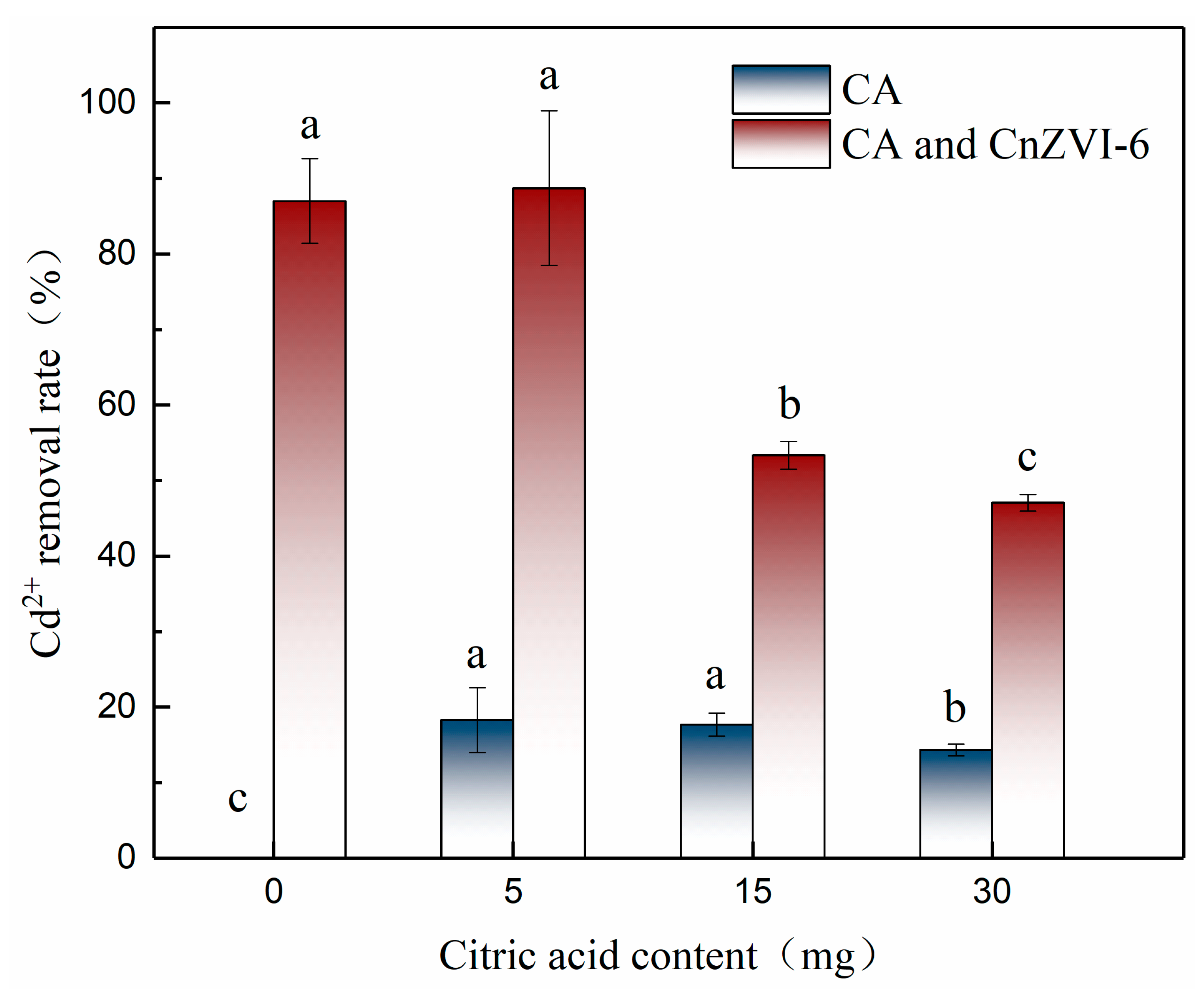
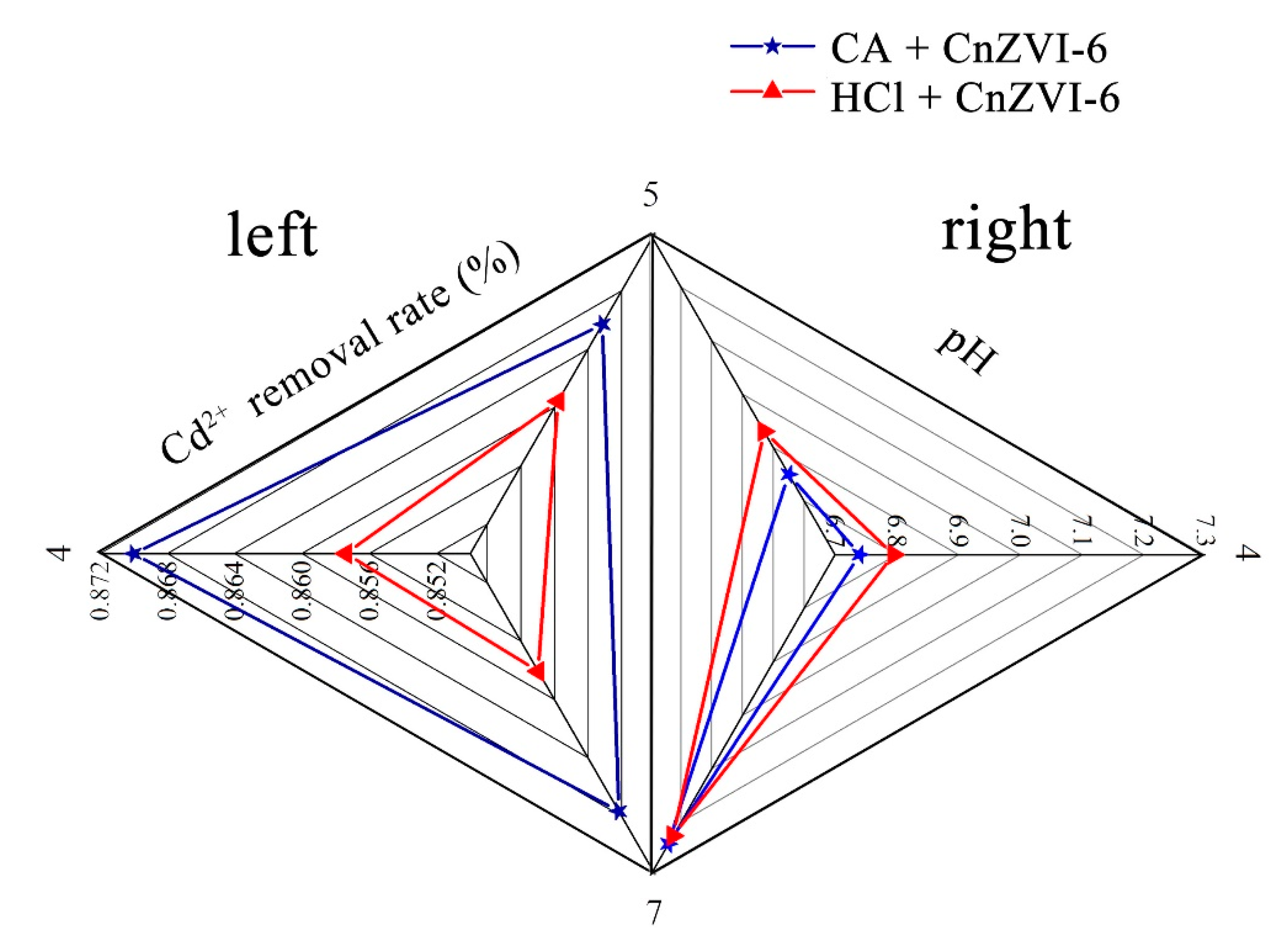


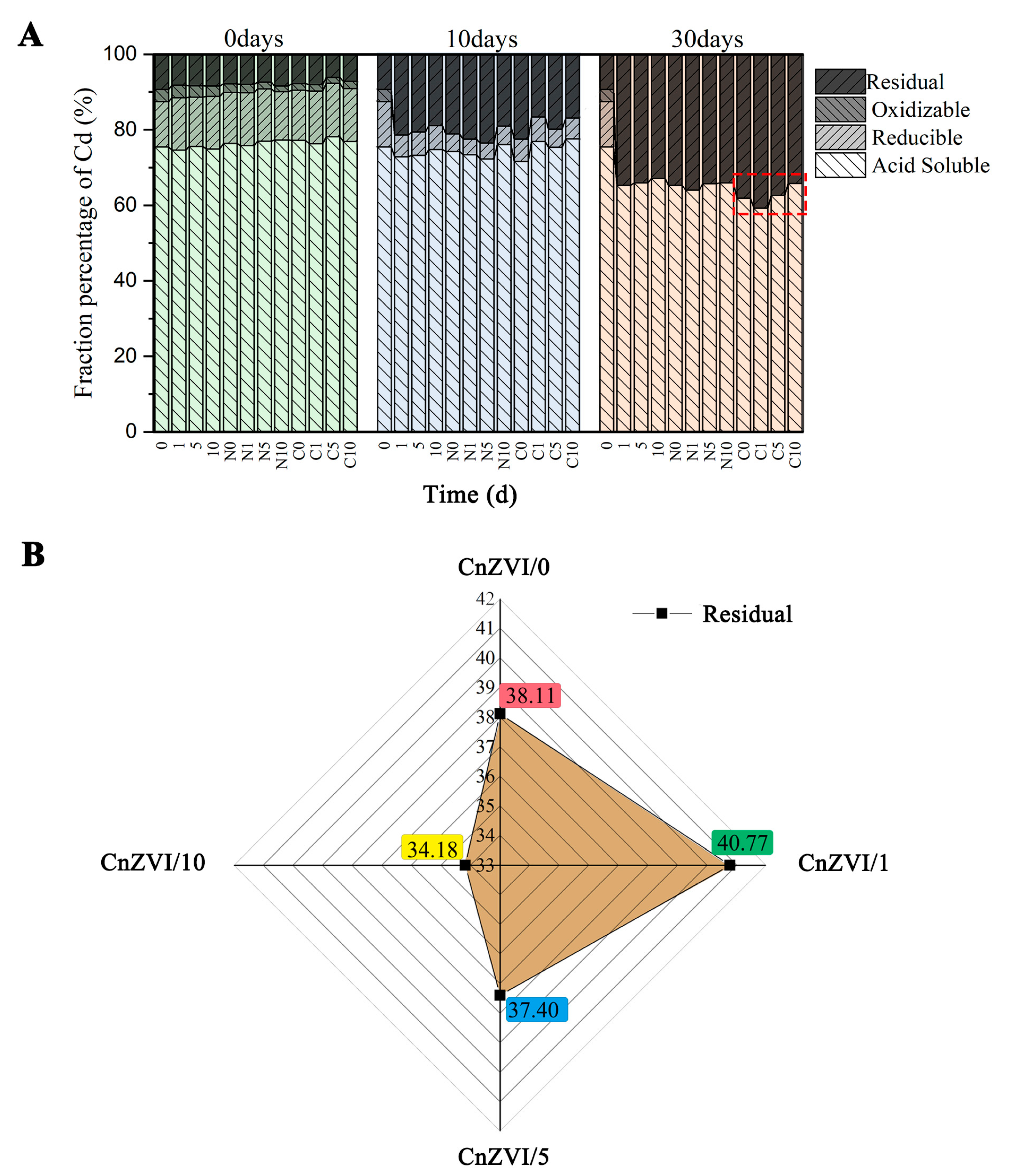
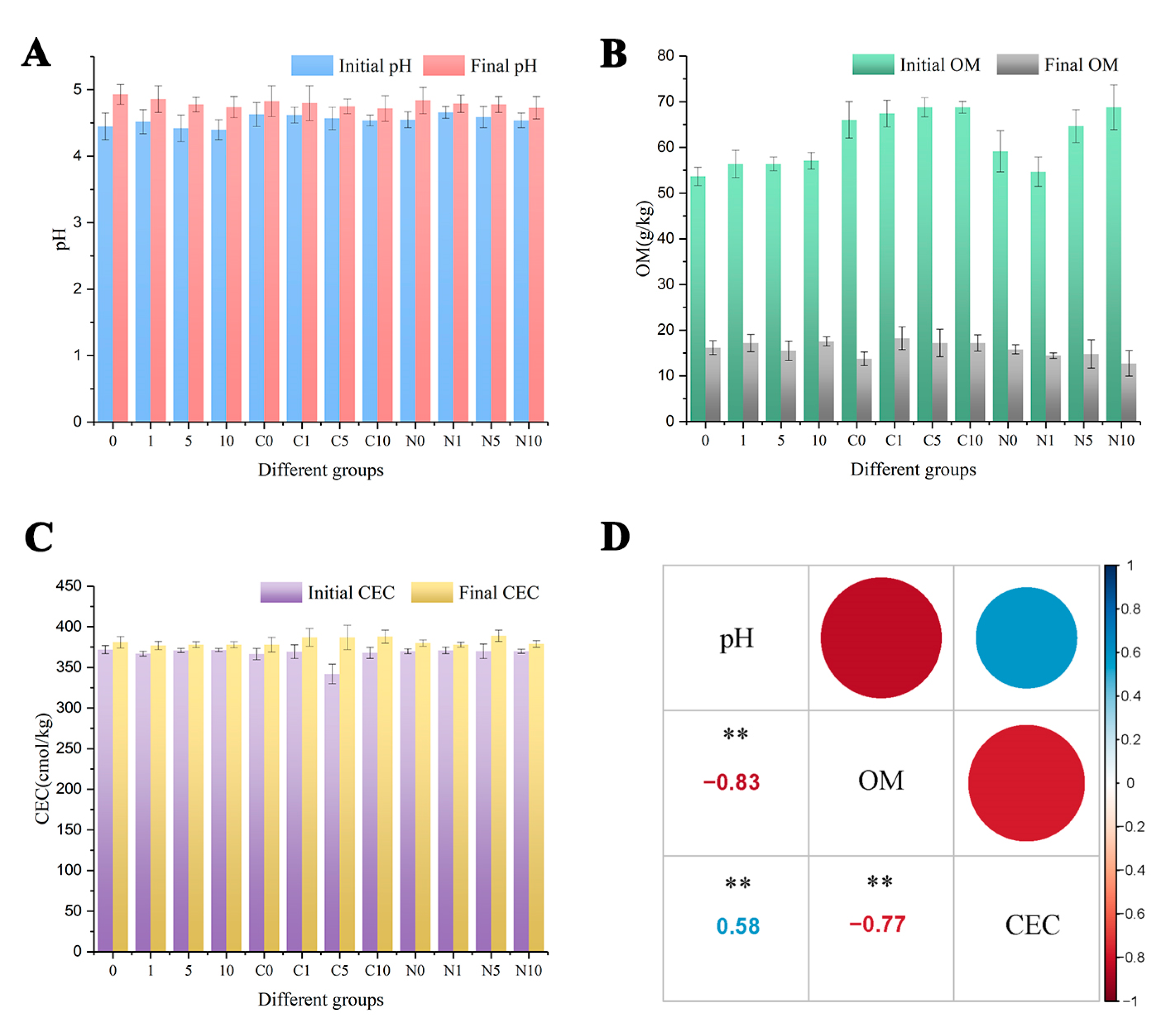
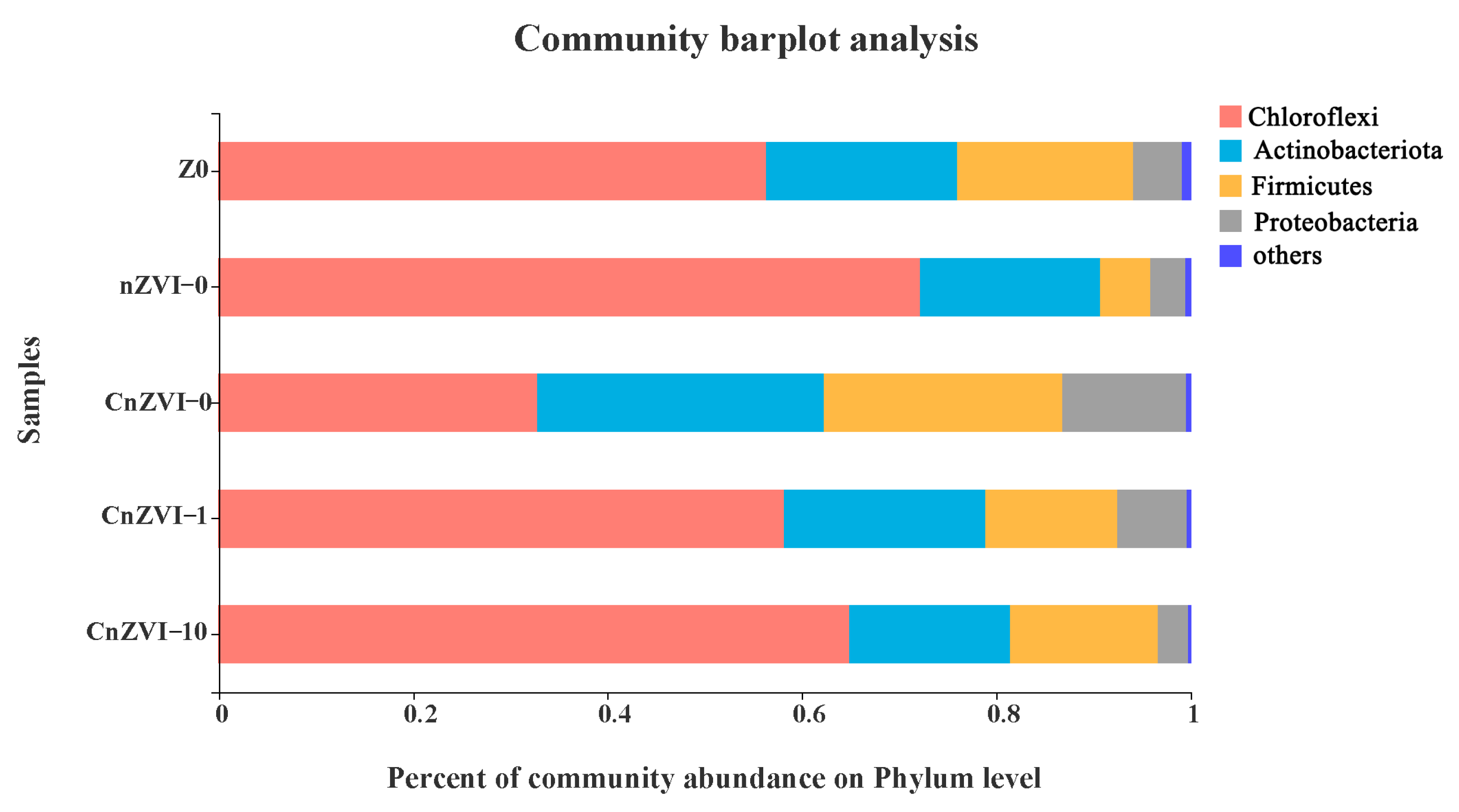
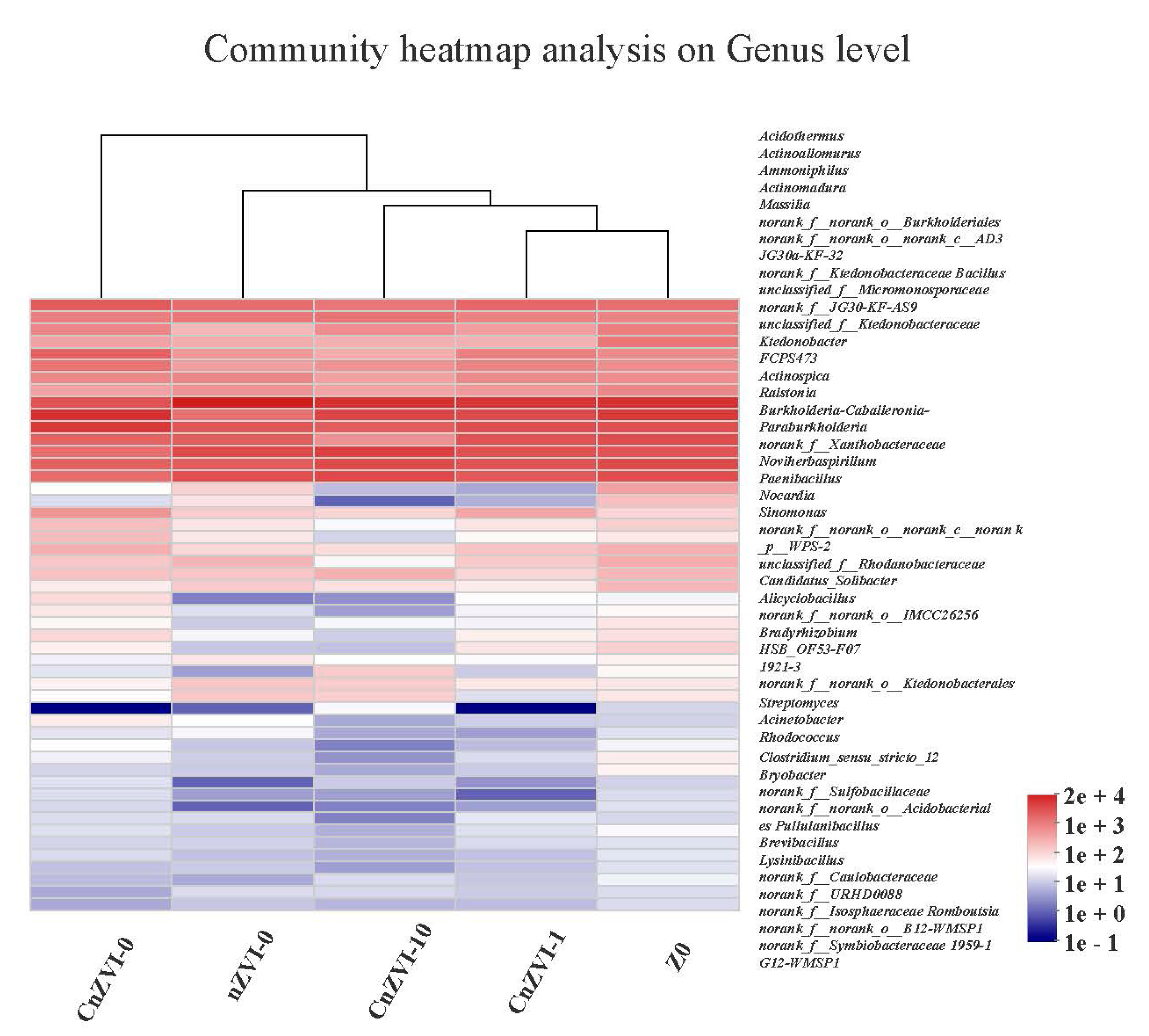

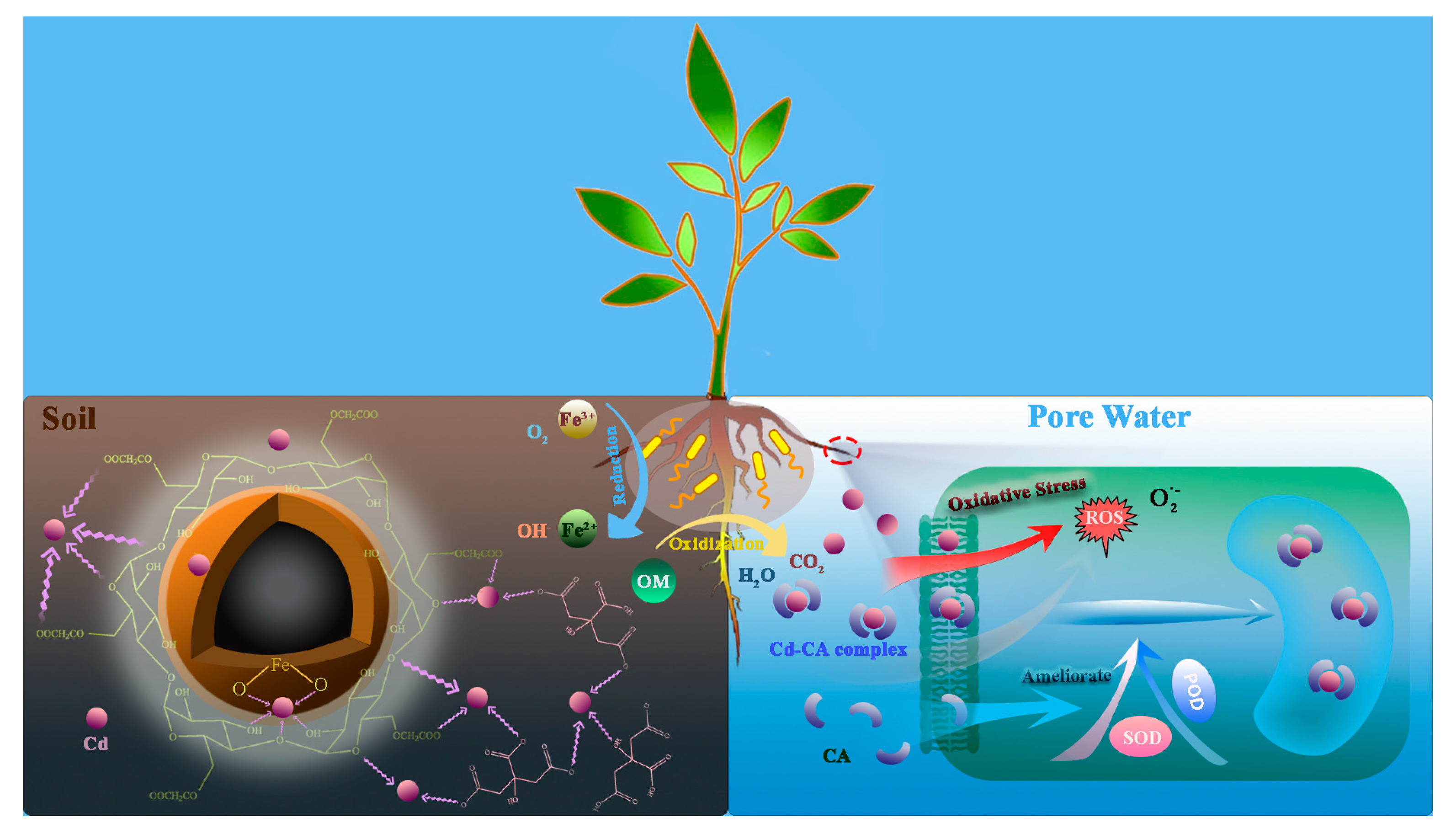
Publisher’s Note: MDPI stays neutral with regard to jurisdictional claims in published maps and institutional affiliations. |
© 2021 by the authors. Licensee MDPI, Basel, Switzerland. This article is an open access article distributed under the terms and conditions of the Creative Commons Attribution (CC BY) license (https://creativecommons.org/licenses/by/4.0/).
Share and Cite
Huang, D.; Yang, Y.; Deng, R.; Gong, X.; Zhou, W.; Chen, S.; Li, B.; Wang, G. Remediation of Cd-Contaminated Soil by Modified Nanoscale Zero-Valent Iron: Role of Plant Root Exudates and Inner Mechanisms. Int. J. Environ. Res. Public Health 2021, 18, 5887. https://doi.org/10.3390/ijerph18115887
Huang D, Yang Y, Deng R, Gong X, Zhou W, Chen S, Li B, Wang G. Remediation of Cd-Contaminated Soil by Modified Nanoscale Zero-Valent Iron: Role of Plant Root Exudates and Inner Mechanisms. International Journal of Environmental Research and Public Health. 2021; 18(11):5887. https://doi.org/10.3390/ijerph18115887
Chicago/Turabian StyleHuang, Danlian, Yunhe Yang, Rui Deng, Xiaomin Gong, Wei Zhou, Sha Chen, Bo Li, and Guangfu Wang. 2021. "Remediation of Cd-Contaminated Soil by Modified Nanoscale Zero-Valent Iron: Role of Plant Root Exudates and Inner Mechanisms" International Journal of Environmental Research and Public Health 18, no. 11: 5887. https://doi.org/10.3390/ijerph18115887
APA StyleHuang, D., Yang, Y., Deng, R., Gong, X., Zhou, W., Chen, S., Li, B., & Wang, G. (2021). Remediation of Cd-Contaminated Soil by Modified Nanoscale Zero-Valent Iron: Role of Plant Root Exudates and Inner Mechanisms. International Journal of Environmental Research and Public Health, 18(11), 5887. https://doi.org/10.3390/ijerph18115887




